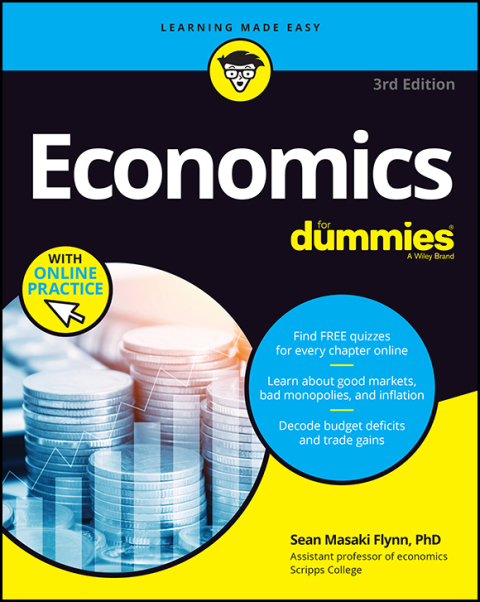Description
Efnisyfirlit
- Cover
- Introduction
- About This Book
- Foolish Assumptions
- Icons Used in This Book
- Beyond the Book
- Where to Go from Here
- Part 1: Economics: The Science of How People Deal with Scarcity
- Chapter 1: What Economics Is and Why You Should Care
- Considering a Little Economic History
- Framing Economics as the Science of Scarcity
- Sending Microeconomics and Macroeconomics to Separate Corners
- Understanding How Economists Use Models and Graphs
- Chapter 2: Cookies or Ice Cream? Exploring Consumer Choices
- Describing Human Behavior with a Choice Model
- Pursuing Personal Happiness
- You Can’t Have Everything: Examining Limitations
- Making Your Choice: Deciding What and How Much You Want
- Exploring Violations and Limitations of the Economist’s Choice Model
- Chapter 3: Producing Stuff to Maximize Happiness
- Figuring Out What’s Possible to Produce
- Deciding What to Produce
- Promoting Technology and Innovation
- Part 2: Microeconomics: The Science of Consumer and Firm Behavior
- Chapter 4: Supply and Demand Made Easy
- Deconstructing Demand
- Sorting Out Supply
- Bringing Supply and Demand Together
- Price Controls: Keeping Prices Away from Market Equilibrium
- Chapter 5: Introducing Homo Economicus, the Utility-Maximizing Consumer
- Choosing by Ranking
- Getting Less from More: Diminishing Marginal Utility
- Choosing Among Many Options When Facing a Limited Budget
- Deriving Demand Curves from Diminishing Marginal Utility
- Chapter 6: The Core of Capitalism: The Profit-Maximizing Firm
- A Firm’s Goal: Maximizing Profits
- Facing Competition
- Analyzing a Firm’s Cost Structure
- Comparing Marginal Revenues with Marginal Costs
- Pulling the Plug: When Producing Nothing Is Your Best Bet
- Chapter 7: Why Economists Love Free Markets and Competition
- Ensuring That Benefits Exceed Costs: Competitive Free Markets
- When Free Markets Lose Their Freedom: Dealing with Deadweight Losses
- Hallmarks of Perfect Competition: Zero Profits and Lowest Possible Costs
- Chapter 8: Monopolies: Bad Behavior without Competition
- Examining Profit-Maximizing Monopolies
- Comparing Monopolies with Competitive Firms
- Considering Good Monopolies
- Regulating Monopolies
- Chapter 9: Oligopoly and Monopolistic Competition: Middle Grounds
- Oligopolies: Looking at the Allure of Joining Forces
- Understanding Incentives to Cheat the Cartel
- Regulating Oligopolies
- Studying a Hybrid: Monopolistic Competition
- Part 3: Applying the Theories of Microeconomics
- Chapter 10: Property Rights and Wrongs
- Allowing Markets to Reach Socially Optimal Outcomes
- Examining Externalities: The Costs and Benefits Others Feel from Your Actions
- Tragedy of the Commons: Overexploiting Commonly Owned Resources
- Chapter 11: Asymmetric Information and Public Goods
- Facing Up to Asymmetric Information
- Providing Public Goods
- Chapter 12: Health Economics and Healthcare Finance
- Defining Health Economics and Healthcare Finance
- Noting the Limits of Health Insurance
- Comparing Healthcare Internationally
- Inflated Demand: Suffering from “Free” and Reduced-Cost Healthcare
- Investigating Singapore’s Secrets
- Chapter 13: Behavioral Economics: Investigating Irrationality
- Explaining the Need for Behavioral Economics
- Complementing Neo-Classical Economics with Behavioral Economics
- Examining our Amazing, Efficient, and Error-Prone Brains
- Surveying Prospect Theory
- Countering Myopia and Time Inconsistency
- Gauging Fairness and Self-Interest
- Part 4: Macroeconomics: The Science of Economic Growth and Stability
- Chapter 14: How Economists Measure the Macroeconomy
- Getting a Grip on the GDP (and Its Parts)
- Diving In to the GDP Equation
- Making Sense of International Trade and Its Effect on the Economy
- Chapter 15: Inflation Frustration: Why More Money Isn’t Always Good
- Buying an Inflation: When Too Much Money Is a Bad Thing
- Measuring Inflation
- Pricing the Future: Nominal and Real Interest Rates
- Chapter 16: Understanding Why Recessions Happen
- Introducing the Business Cycle
- Striving for Full-Employment Output
- Returning to Y*: The Natural Result of Price Adjustments
- Responding to Economic Shocks: Short-Run and Long-Run Effects
- Heading toward Recession: Getting Stuck with Sticky Prices
- Achieving Equilibrium with Sticky Prices: The Keynesian Model
- Chapter 17: Fighting Recessions with Monetary and Fiscal Policy
- Stimulating Demand to End Recessions
- Generating Inflation: The Risk of Too Much Stimulation
- Figuring Out Fiscal Policy
- Dissecting Monetary Policy
- Chapter 18: Grasping Origins and Effects of Financial Crises
- Understanding How Debt-Driven Bubbles Develop
- Seeing the Bubble Burst
- After the Crisis: Looking at Recovery
- Part 5: The Part of Tens
- Chapter 19: Ten Seductive Economic Fallacies
- The Lump of Labor
- The World Is Facing Overpopulation
- Sequence Indicates Causation
- Protectionism Is the Best Solution to Foreign Competition
- The Fallacy of Composition
- If It’s Worth Doing, Do It 100 Percent
- Free Markets Are Dangerously Unstable
- Low Foreign Wages Mean That Rich Countries Can’t Compete
- Tax Rates Don’t Affect Work Effort
- Forgetting Unintended Consequences
- Chapter 20: Ten Economic Ideas to Hold Dear
- Self-Interest Can Improve Society
- Free Markets Require Regulation
- Economic Growth Relies on Innovation
- Freedom and Democracy Make Us Richer
- Education Raises Living Standards
- Intellectual Property Boosts Innovation
- Weak Property Rights Cause All Environmental Problems
- International Trade Is a Good Thing
- Government Can Provide Public Goods
- Preventing Inflation Is Easy
- Chapter 21: Ten (Or So) Famous Economists
- Adam Smith
- David Ricardo
- Karl Marx
- Alfred Marshall
- John Maynard Keynes
- Kenneth Arrow and Gerard Debreu
- Milton Friedman
- Paul Samuelson
- Robert Solow
- Gary Becker
- Robert Lucas
- Appendix: Glossary
- About the Author
- Advertisement Page
- Connect with Dummies
- Index
- End User License Agreement






Reviews
There are no reviews yet.